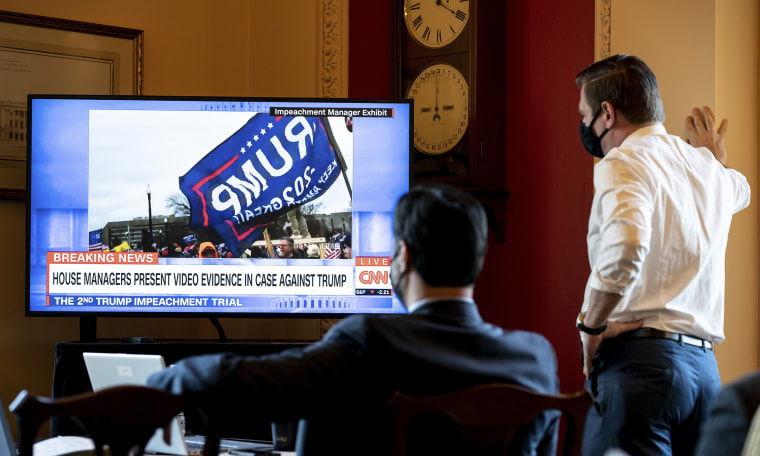The Senate held its first hearings into the Jan. 6 attack on the Capitol on Tuesday. And I have to be honest: I was not impressed.
Neither the senators nor their witnesses addressed the toughest questions: Why didn’t you see what so many civilians did?
The cadre of former Capitol security chiefs testifying might as well have played a continuous recorded loop of them reciting in unison, “the intelligence wasn’t there,” in response to senators’ equally redundant questions about the Capitol security failure and why adequate resources weren’t deployed.
But neither the senators nor their witnesses addressed the toughest questions: Why didn’t you see what so many civilians did? What biases fed into the many incorrect assumptions made? And what keeps us collectively — as Americans, as law enforcement, and more specifically, as white people — from perceiving our own as a potential threat? The answers are complex — but the right questions need to be asked first.
The more that former Capitol Police Chief Steven Sund, former House Sergeant-at-Arms Paul Irving, and former Senate Sergeant-at-Arms Michael Stenger repeated their “intelligence was lacking” mantra, the less intelligent they sounded. Irving stated, “We did discuss whether the intelligence warranted having troops at the Capitol, and our collective judgment at that time was no, the intelligence did not warrant that." Sund testified that “the level of probability of acts of civil disobedience/arrests on Jan. 6 ranged from 'remote' to 'improbable'" and that “none of the intelligence we received predicted what actually occurred.”
Perhaps the dozens of intelligence professionals on Sund’s staff should include the cost of newspaper subscriptions and laptops in their next budget request. The truth is that there was significant online chatter and numerous media reports that protestors were targeting the electoral vote count. So then, what is it that keeps law enforcement professionals from seeing what’s right in front of them?
Perhaps the dozens of intelligence professionals on Sund’s staff should include the cost of newspaper subscriptions and laptops in their next budget request.
As these hearings continue, we will likely hear from the FBI and other law enforcement leaders. Importantly, we can expect to hear about the legal constraints on what that agency can and cannot do about monitoring social media, penetrating protests groups and investigating domestic extremism. These limits rightfully help preserve our civil liberties, free speech and freedom of association. And it’s true that law enforcement can’t possibly see and assess the universe of social media even if such monitoring were allowed. But plenty of social media posts prior to the insurrection spoke of violence, vandalism and targeting the Capitol — those things have little to do with exercising civil liberties.
After the insurrection, two ProPublica journalists interviewed 19 current and former U.S. Capitol Police officers about the assault on the Capitol. They also obtained confidential intelligence bulletins and previously unreported planning documents. Significantly, their reporting provides something other than the convenient “intelligence failure” rationale as to why planning was so poor when it came to protecting our iconic symbol of democracy.
The interviews also revealed officers’ concerns about disparities in the way the force prepared for Black Lives Matter demonstrations versus the pro-Trump protests on Jan. 6. Officers said the Capitol Police force usually plans intensively for protests, even if they are deemed unlikely to grow violent. Officers said they spent weeks working 12- or 16-hour days, poised to fight off a riot, after George Floyd was killed by Minneapolis police — even though intelligence suggested there was not much danger from protesters.
“We had intel that nothing was going to happen — literally nothing,” said one former official with direct knowledge of planning for the Black Lives Matter demonstrations. “The response was, ‘We don’t trust the intel.'"
Law enforcement and security officials are trained to ensure that the planning, posture and presence for an event is commensurate with the intelligence, threat and risk. When those things don’t match up, cops notice — and they ask questions. What these cops are telling us is that when there’s no indication of threat or risk for a Black Lives Matter demonstration, they were told to prepare for a riot.
Yet, when social media was screaming threat and risk for Jan. 6, the planning, posture and presence didn’t come close to matching the available intelligence. This wasn’t about legal constraints or resources; this was about our collective inability to see people who look like us as a serious threat. Moreover, it’s about the ease with which we so quickly assess as a threat those who are different.
“Based on the intelligence, we all believed that the plan met the threat and that we were prepared," Irving testified, "We now know that we had the wrong plan."
Did they really have the wrong plan? Or did they, like so many of us, have the wrong perspective? Sund urged intellience agencies to "open the aperture" and “provide a broader range of information to Capitol Police."
But is it an aperture that needs to be opened, or is it our minds? We may not hear the questions I’ve asked here during the next rounds of Senate hearings. We still need to start asking them of ourselves — even if we won’t like the answers.

